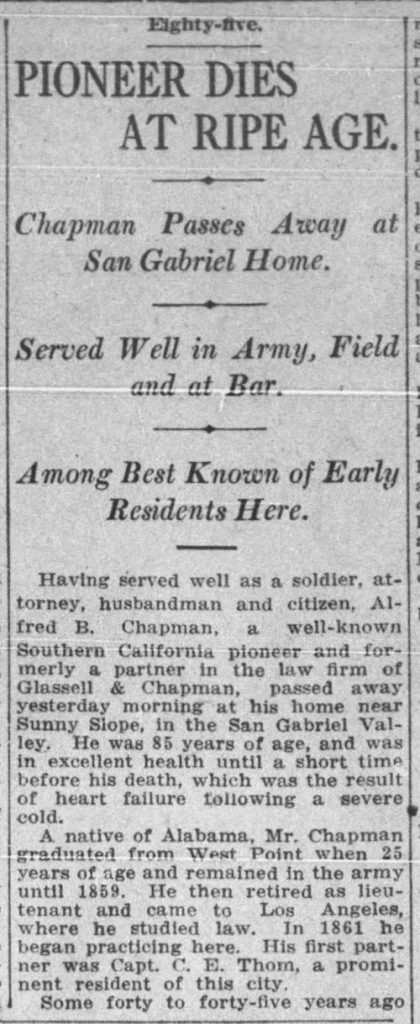Alfred Beck Chapman in 1879 bought about 1,600 acres of the Rancho Santa Anita from Duarte Road to the foothills, eventually harvesting fruit from nearly 10,000 citrus trees. His ranch included the present Chapman Woods as well as the Hastings Ranch area.

Chapman married Mary Scott, the daughter of Los Angeles attorney Jonathan R. Scott, with whom he studied law. In 1861 he set up a partnership with Cameron E. Thom.
In 1863 Chapman became city attorney of Los Angeles, replacing Myer J. Newmark, who resigned, and in 1868 he was elected district attorney of Los Angeles County. He went into partnership with a boyhood friend, Andrew Glassell, when the latter arrived in Los Angeles in 1866. Colonel George H. Smith, a former Confederate Army officer and brother-in-law of Glassell, joined the firm in 1870. Their law practice was confined chiefly to real estate transactions, and they made their fortunes by handling the large partition suits. Chapman was the businessman of the firm. He took his compensation in land, and nearly every final decree in partition would find that Glassell & Chapman had acquired more property.
Chapman and Glassell are best known in Orange County for being founders of Orange, California. The firm represented the Yorba and Peralta families in the partitioning of Rancho Santiago de Santa Ana in 1867, and had received for a portion of their fees certain large parcels of land in the partition. He joined with one of his partners, Andrew Glassell, to develop a new community, Richland (which would eventually be named Orange). They hired the land surveyor, Frank Lecouvrier of Los Angeles, to map this tract, which they called Richland Farm District. ‘Richland’ was originally the name of the Virginia plantation owned by the father of Andrew Glassell in the 1830s.
A large transaction by Chapman and Glassell was the legal suit known as “The Great Partition of 1871”, brought against the Verdugo Rancho San Rafael properties on the Los Angeles River and in the Verdugo Mountains. The legal fees were again paid in substantial land transfers. He at one time also owned “practically all the land” where Glendale, California, and the suburb of Tropico were established.[9]
Chapman continued to practice law until 1880. After retirement, he devoted full-time to managing his 700-acre rancho in the upper San Gabriel Valley, a portion of the Rancho Santa Anita grant, and became involved in citrus production.
The neighborhood of Chapman Woods in Pasadena, the site of Chapman’s rancho in the San Gabriel Valley, is named after Alfred Chapman.
From Wikipedia

